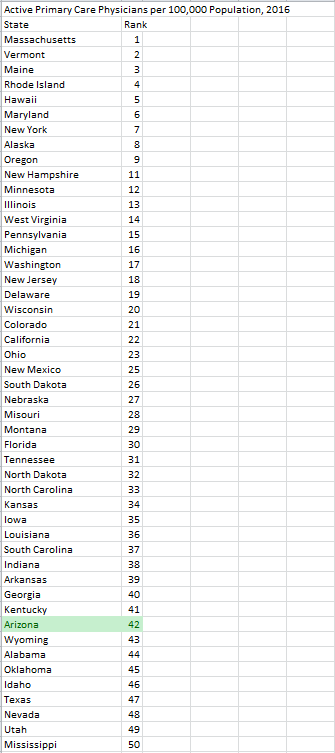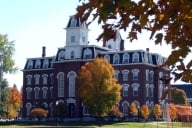You have /5 articles left.
Sign up for a free account or log in.
It is based in Nebraska and its mascot is a blue jay -- and it's expanding to a high-rise in Phoenix.
But please, don’t call it Snowbird Medical School.
Creighton University, the Jesuit institution that dates back to 1878, is building a new, $99 million, 200,000-square-foot medical training facility a long way from its Omaha home. Its chosen location: an up-and-coming retail and office park in the Arizona capital, nearly 1,300 miles away. Creighton also plans to expand its nursing program there, among others, to keep up with booming demand in a region that experts say is badly in need of medical care. Though a partnership with three Phoenix medical providers will operate the medical school, Creighton is funding the construction itself via cash reserves, debt and fund-raising in the Phoenix area.
The move stands in stark contrast to Creighton’s 2016 sale of its Omaha hospital, a decision made because the university “really didn’t have the income and the clientele base” to support it, said the Reverend Daniel S. Hendrickson, Creighton’s president.
The former Creighton University Medical Center is now being developed into a $110 million complex of upscale apartments at the western edge of campus, Father Hendrickson said. The university is maintaining its Omaha medical school.
The new Phoenix facility is expected to open in the fall of 2021 in the city’s Midtown area with nearly 900 students by 2024. The property is at the edge of a large mixed-use office and retail complex called Park Central, which began life more than 50 years ago as Park Central Shopping City, one of the country’s first malls. Before developers purchased the 46-acre property and built a mall, which opened in 1957, it was a dairy.
In its most recent state-by-state analysis, the Association of American Medical Colleges ranked Arizona 42nd nationwide in the number of active primary-care physicians per 100,000 people, ahead of just eight states: Wyoming, Alabama, Oklahoma, Idaho, Texas, Nevada, Utah and Mississippi.
Negotiations for the project date back to 2016, when Creighton and several partners formed the Creighton University-Arizona Health Education Alliance. But Creighton has had a presence in Phoenix since 2005, when St. Joseph’s Hospital asked if Creighton's medical students would consider a monthlong summer residency there.
In 2012, Creighton began training third- and fourth-year medical students in Phoenix, and three years later it added pharmacy students. By 2018, it was educating a series of 48-student nursing student cohorts in an accelerated, 12-month program.
“In some ways Phoenix has been telling us two things: ‘Hurry up’ and ‘Do more,’” said Father Hendrickson.
Creighton eventually settled on three partners for the new medical school: St. Joseph’s; District Medical Group, a large nonprofit; and Maricopa Integrated Health System, the county’s longtime public hospital system.
Father Hendrickson said Maricopa Integrated’s commitment to caring for the poor in the Phoenix area made it an appealing partner. “We’re Jesuit and Catholic -- Maricopa is public,” he said. “And yet there’s this great sense of mission and outreach with the underserved.”
Maricopa Integrated already runs 10 residency programs with more than 350 residents -- it has trained doctors since 1952. Its CEO, Steve Purves, said it runs the oldest public teaching hospital in the state. But the hospital-based program was looking for a partnership with a university-sponsored one. At the same time, he said, Creighton “needed to provide a way to expand -- and a key part of that is access to clinical training sites, which hospitals provide.”
Purves called the partnership “a great strategic coming together -- the stars lined up.”

While Arizona is particularly in need of doctors, AAMC data show that, over all, the U.S. faces a severe physician shortage. The most recent analysis by the medical education group shows a possible shortage of as many as 121,300 physicians by 2030. That’s considerably higher than last year’s projected shortfall of up to 104,900 -- the new estimates reflect “model updates,” as well as recently revised federal designations for primary care and mental health.
The group now predicts shortages in four broad categories: primary care, medical specialties, surgical specialties and other specialties. By 2030, it finds, we could see shortfalls of between 14,800 and 49,300 primary care physicians alone. It sees a “largely stagnant” pool of surgical specialists.
Much of the overall projected shortage comes courtesy of a growing population that is also aging, with “increasingly complex care” needs. By 2030, the U.S. population is expected to grow by nearly 11 percent, while the age-65-and-over population is expected to grow by 50 percent. Meanwhile, the under-18 population is projected to grow by just 3 percent.
But the group predicts that within the next decade, one in three active doctors will reach or exceed retirement age.
In Phoenix, Creighton already had access to St. Joseph’s, its longtime hospital partner. But by building its own school, it saw a chance to expand its available clinical sites beyond a single hospital. The state’s two large public medical schools -- both based at the University of Arizona -- are affiliated with Banner Health, a Maricopa Integrated competitor.
“There’s lots of open space for both health-care education and health-care practitioners for the Phoenix area at large,” Father Hendrickson said. He noted that Arizona State University gave its blessing to the Phoenix expansion -- actually, Creighton is also negotiating an agreement with ASU to train its occupational and physical therapists and pharmacists.
The university has also established a kind of informal undergraduate pipeline with Brophy College Preparatory, a private Jesuit high school in Phoenix, that it hopes will eventually provide students to the medical school.
“We have a golden opportunity to share the Creighton mission in a new part of the United States,” Father Hendrickson said.








